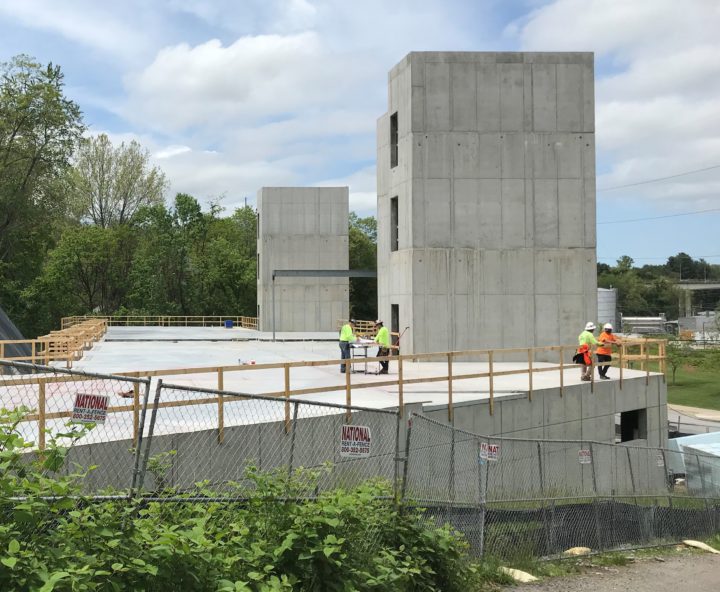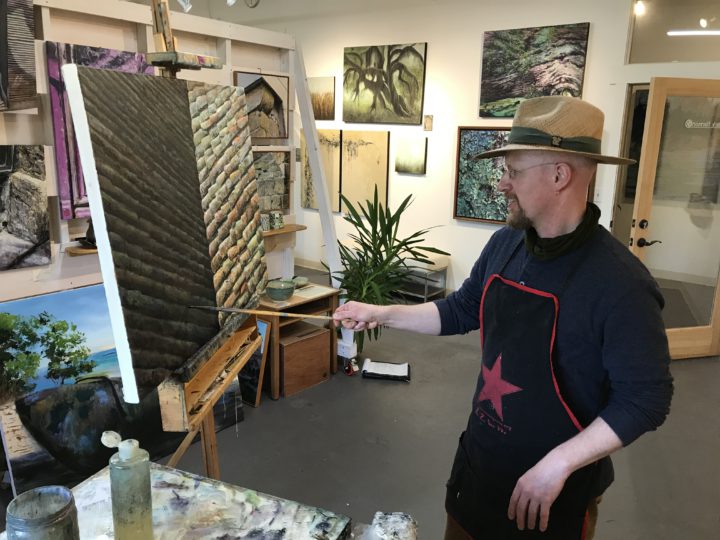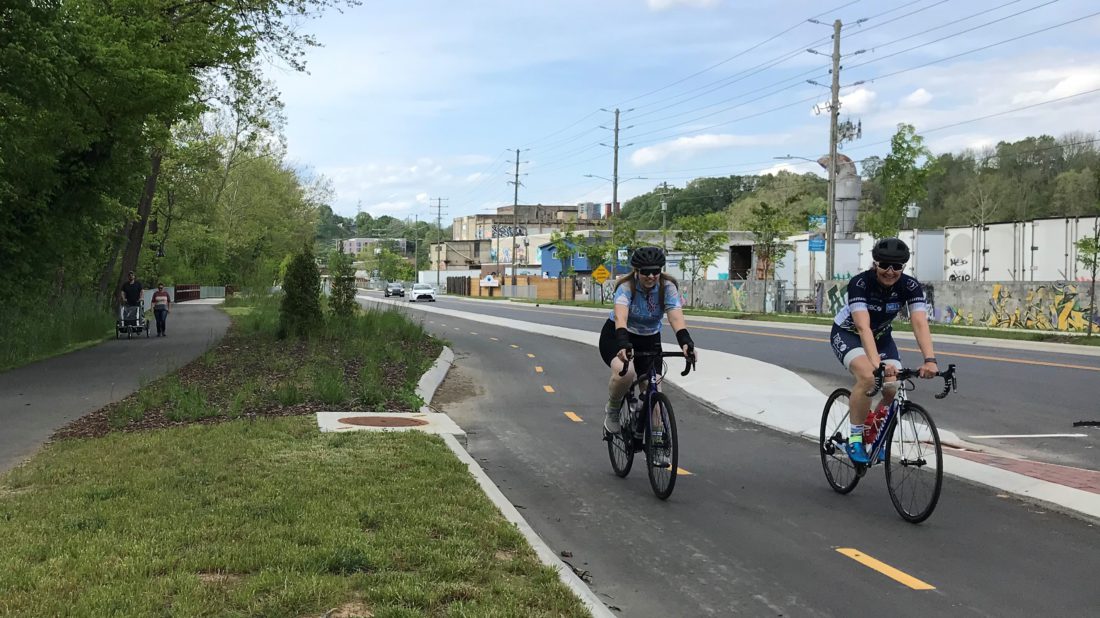Russ Towers might just be on to something.
The co-owner of Second Gear started the business selling used outdoor equipment on Haywood Road in 2004, during what he calls the “early stages” of West Asheville’s renaissance. Since then, the area has seen a tremendous rise in activity along Haywood Road and demand for housing in the adjacent neighborhoods.
Now Second Gear is moving to a location in the River Arts District, and all signs indicate Asheville’s urban riverfront on the east side of the French Broad River is already well on its way to a transition similar to what has occurred in the neighborhood Second Gear is leaving.
The most recent catalyst is completion of city government’s RADTIP project, which brought greenway paths, improved streets, additional park space, more parking, landscaping, sidewalks, public art, seating, measures to handle stormwater, swings and much improved facilities for bicycles to the roughly 2-mile stretch of riverfront between the Amboy Road/Lyman Street/Meadow Road intersection to the south to a point just north of the railroad bridge over Riverside Drive.
Construction of RADTIP — the River Arts District Transportation Improvement Project — began in 2018, greatly aided by a federal grant. Completion, officially celebrated with a series of activities in late April and early May, is a major milestone in the decadeslong process of returning life to an area once dominated by industrial buildings, many empty and decaying, and weedy vacant lots.
Locals and tourists alike have embraced the new paths, with a steady stream of people walking, running, bicycling, skateboarding, inline skating and pushing or being pushed in wheelchairs or baby buggies.
The RAD “is clearly emerging and growing in popularity and growing in the variety of things to do,” says Towers, who is also a real estate investor and former broker.
The question now is what comes next for an area that attracted artists partly because of its gritty feel and cheap studio space. Some predict high demand for residential and retail space, as illustrated by several development projects planned or under construction. There are also fears that rising real estate prices may eventually push out some of the artists who have helped make the RAD a magnet.
‘We have all dreamed together’
So far, the reviews of RADTIP itself and its centerpiece Wilma Dykeman Greenway from greenway users and others in the RAD generally amount to two thumbs up — way up, in fact.
“It’s fabulous. … It’s going to draw people here,” says Patricia Hargrove, a portrait artist whose Roberts Street studio has a view of the greenway. “I see tons of people using it all the time.”
North Asheville resident Wesley Culpepper says he runs on the greenway practically every day: “I love it.”
Getting close to the river was a daunting prospect when Helaine Greene and her sister, Trudy Gould, moved part of their candle-making business into a mostly vacant industrial building that subsequently became Riverview Station in 1990. “If you wanted to walk by the river you literally took your life into your own hands,” Greene recalls. “The traffic was intense and speeding by.”
Greene and Gould now co-own the building at 190 Lyman St., and it is full of artist studios and other businesses. The neighborhood has changed, too. Now, Greene said in remarks to an April 23 online celebration of RADTIP’s completion, “It is just beautiful and so peaceful to walk right by the river. … It is a beautiful project that we have all dreamed together.”
The RAD was changing well before RADTIP was finished. From 2010-20, the number of restaurants in the area grew from three to 15, recreation businesses increased from two to five, and the number of artists grew from about 140 in 16 buildings to more than 250 in 19 buildings, Mayor Esther Manheimer said at the April 23 event.
City government leaders for years have considered the area one of Asheville’s next logical areas for growth, particularly after state legislators early last decade made it much harder for the city to annex land along its outskirts. The nonprofit RiverLink has encouraged people to come to the French Broad and Swannanoa rivers for recreation, housing and commerce since the 1980s. Parks and paths developed on the French Broad along Amboy Road and the arrival of New Belgium Brewing Co. on Craven Street in 2016 are among several factors that focused attention on the RAD.
Developers have dreams of their own for the district. Construction is underway on Radview, offering 24 studio apartments and some artist studios off Roberts Street, and on The Landings, comprising 40 upscale condominiums near New Belgium. RiverLink hopes to sell property it owns on Riverside Drive to a developer planning 150-170 housing units in a mixed-use building, but those plans are contingent on approval by Asheville City Council. Work has begun to convert a former grocery warehouse on Roberts Street into a 70-room hotel.

Radview developer Jeremy Goldstein says he bought the property three years ago because “I thought it would be an amazing place for people to live and work.” Knowing RADTIP was on its way was among the reasons he picked the site. He expects high demand because “almost nobody lives in the River Arts District” due to a lack of housing, he says.
Access to the French Broad and the greenways beside it is “a great amenity” for The Landings, says Cheri Bomar, an official with the Pennsylvania company developing the project. Without them, “I’m not sure we would have” made the investment, she adds.
The RAD ‘wants to blow up’
Artists in the RAD praise the greenway and other improvements the city has completed, and several expect the upgrades will bring more art buyers to their studios. But the “G word” — gentrification — comes up frequently in their comments about what may happen next.
“I’m concerned that we’ll get gentrified out,” says Sarah Wells Rolland, owner of The Village Potters. “If real estate investors start coming in and buying up [space now used for studios], artists could face potential cost increases that we couldn’t shoulder.”
Growth in the district will help some artists and businesses, but “a rising tide does not lift all boats,” says painter Mark Harmon.
At present, it is difficult to find any signs that large numbers of artists are being pushed out over cost issues. Karen Maugans, a photographer who heads the nonprofit River Arts District Artists group, says there is high demand for studio space in the RAD and the number of artists in the area is still increasing. She says that worries about gentrification are nothing new, but many building owners are “deeply invested in the success of the artists” and are keeping rents reasonable.
Some in the real estate industry say the area is a logical place for residential and business growth. Restrictions imposed because of the danger of flooding will make it harder to convert artists’ studios to other uses, they point out.
“I think (the RAD) wants to blow up” with new investment, says Eddie Dewey, principal at Dewey Property Advisors, a real estate brokerage and management company that handles several properties in the district. “That’s where people are going to want to be.” He says Asheville must figure out ways to manage change brought about by increased popularity with tourists that don’t harm the interests of those already living here.

The RAD’s central location means residents will be able to use alternative means of transportation instead of adding to auto traffic congestion, says Goldstein, noting that he sees that reflected in comments from prospective tenants: “I’ve already had a few people who are saying, ‘I don’t have a car. I don’t want a car.’”
Most property between the railroad tracks and the French Broad in the RAD is in the regulated flood plain. Government rules require that any extensive renovations of existing structures include expensive measures to avoid flood damage — a significant disincentive for a property owner to convert cheap artist studio space in an old industrial building or warehouse to another use. Similar rules apply to new construction, requiring occupied floors be above the 100-year flood level or that buildings be constructed so that floodwaters can’t get inside. Neither approach is cheap, and an elevated building is a particular challenge for new retail space, as shoppers often resist climbing to upper floors.
Two housing projects planned in the RAD propose to meet the requirements by building parking on lower levels and living space above. That raises affordability issues, since the stacked configuration is more expensive than plopping a building down at ground level in a cow pasture on the edge of town. But it eats up less green space than a more spread-out development in suburbia would and places more people in positions where they have short commutes that can be made by means other than driving.
Given Asheville’s popularity, Goldstein sees growth in the RAD as inevitable and more desirable than construction on the city’s fringes.
“The cat’s out of the bag. … We are known. People are going to move here,” he says. “All we can do now is figure out how to manage that change.”




The riverfront improvements — especially the bike paths — are really impressive and transformative. I hadn’t been down to the RAD in a while during the pandemic months and when I did, on a beautiful fall afternoon, it warmed my heart to see people out on their bicycles and enjoying the expanded sidewalks and greenways. It feels very different.
The proposed 159 Riverside project also looks decently-designed and appropriate for that space.
It’s strange to look back on how the Depot / Roberts Street phase of RAD development briefly fired up then stalled out in the early 2010s. The opening of White Duck / Pizza Pura / The Junction / the Magnetic Field (one of the originators of the local cocktail scene) suggested that it would quickly expand into something bigger, but the hotel boom and the expansion of the South Slope diverted money and attention to places that were closer to downtown.
(All that said, it makes me a little uncomfortable to hear about politically-connected developers like Jeremy Goldstein getting in ahead of the game, given the extended controversy over the bidding process and additional funding for RADTIP. Goldstein was P&Z chair during this period, though perhaps no longer so when he bought the Radview property.)